Intel's Bean Canyon (NUC8i7BEH) Coffee Lake NUC Review - Ticking the Right Boxes
by Ganesh T S on April 3, 2019 8:00 AM EST- Posted in
- Systems
- Intel
- NUC
- UCFF
- Thunderbolt 3
- Cannon Point
- Coffee Lake-U
BAPCo SYSmark 2018
The Intel NUC8i7BEH (Bean Canyon) was evaluated using our Fall 2018 test suite for small-form factor PCs. In the first section, we will be looking at SYSmark 2018.
BAPCo's SYSmark 2018 is an application-based benchmark that uses real-world applications to replay usage patterns of business users in the areas of productivity, creativity, and responsiveness. The 'Productivity Scenario' covers office-centric activities including word processing, spreadsheet usage, financial analysis, software development, application installation, file compression, and e-mail management. The 'Creativity Scenario' represents media-centric activities such as digital photo processing, AI and ML for face recognition in photos and videos for the purpose of content creation, etc. The 'Responsiveness Scenario' evaluates the ability of the system to react in a quick manner to user inputs in areas such as application and file launches, web browsing, and multi-tasking.
Scores are meant to be compared against a reference desktop (the SYSmark 2018 calibration system, a Dell Optiplex 5050 tower with a Core i3-7100 and 4GB of DDR4-2133 memory to go with a 128GB M.2 SATA III SSD). The calibration system scores 1000 in each of the scenarios. A score of, say, 2000, would imply that the system under test is twice as fast as the reference system.

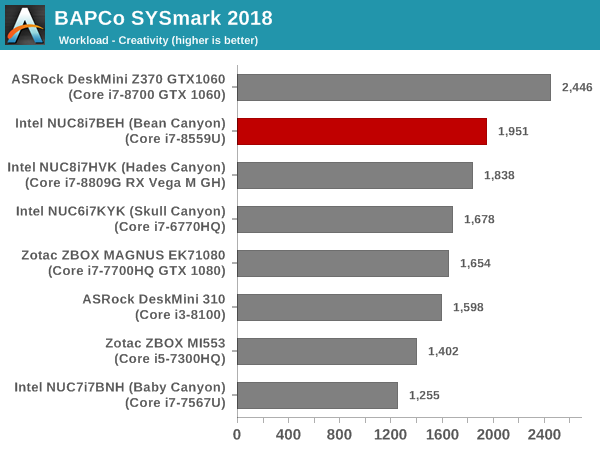

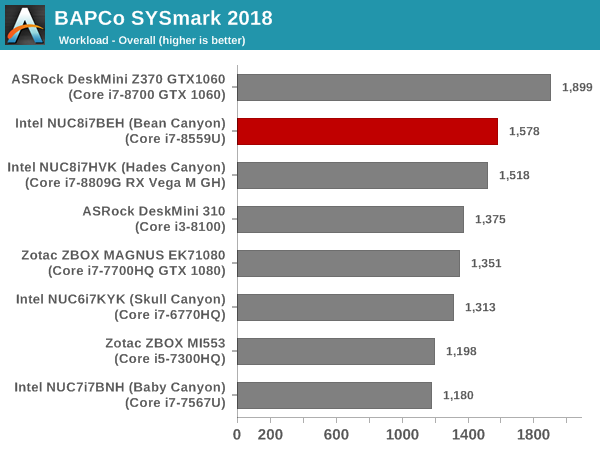
SYSmark 2018 also adds energy measurement to the mix. A high score in the SYSmark benchmarks might be nice to have, but, potential customers also need to determine the balance between power consumption and the efficiency of the system. For example, in the average office scenario, it might not be worth purchasing a noisy and power-hungry PC just because it ends up with a 2000 score in the SYSmark 2014 SE benchmarks. In order to provide a balanced perspective, SYSmark 2018 also allows vendors and decision makers to track the energy consumption during each workload. In the graphs below, we find the total energy consumed by the PC under test for a single iteration of each SYSmark 2018 workload. For reference, the calibration system consumes 5.36 Wh for productivity, 7.71 Wh for creativity, 5.61 Wh for responsiveness, and 18.68 Wh overall.
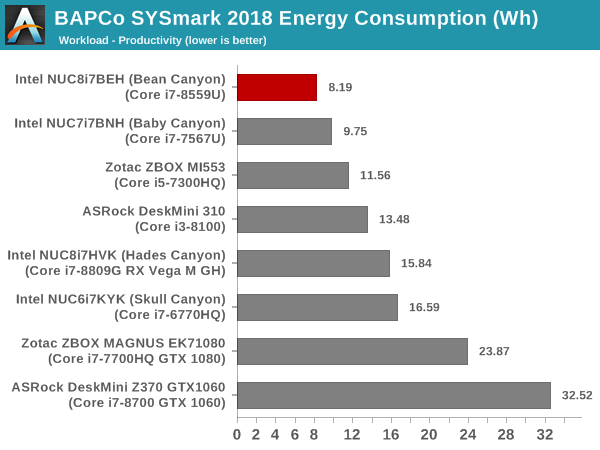
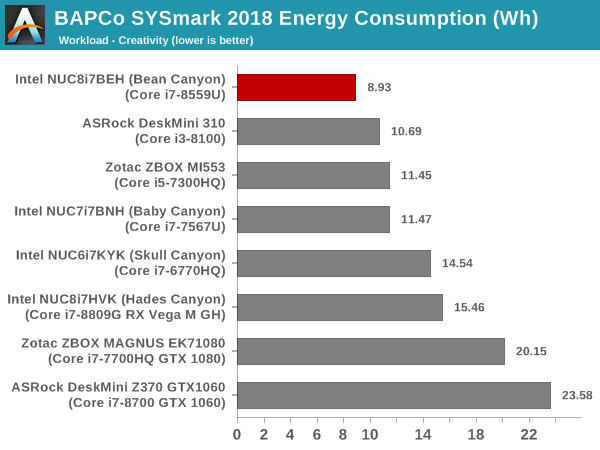
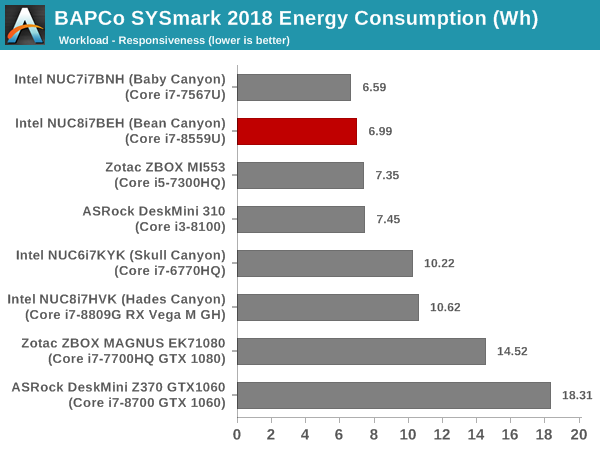
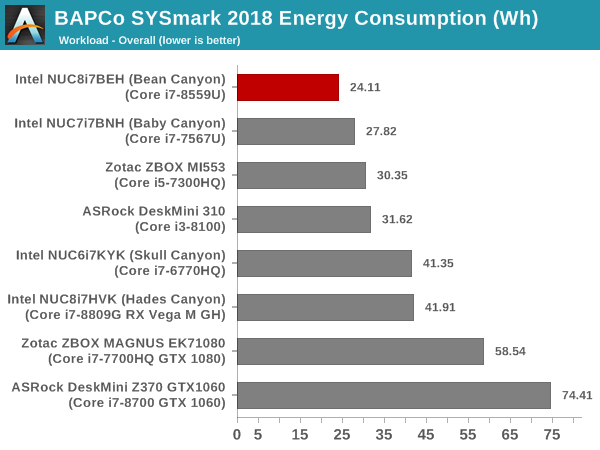
Bean Canyon turns out to be extremely energy efficient compared to almost all of the other PCs that are being compared against it. It loses the performance crown to the hexa-core Core i7-8700-equipped DeskMini Z370 GTX 1060. This is on expected lines, since the Core i7-8700 has a much higher TDP budget compared to the Core i7-8559U. The mini-STX form factor also enables the DeskMini to accommodate a better thermal solution compared to the one in the Intel NUC8i7BEH.










81 Comments
View All Comments
Hixbot - Monday, April 8, 2019 - link
You really need noise measurements in HTPC reviews.vortmax2 - Tuesday, April 9, 2019 - link
Any try an eGPU setup using the TB port? How's it work?vortmax2 - Tuesday, April 9, 2019 - link
Just read through the entire article now and noticed they already tested it...looks like a neat little gaming rig.alpha754293 - Tuesday, April 9, 2019 - link
TL;DR: If you don't do much with it, it's great. Else; it's severely thermally castrated.My biggest problem with this unit is the fact that at full load, the processor CANNOT run at full speed that it otherwise SHOULD be able to run at due to Intel's crappy thermal management solution that they have designed and engineered for this.
You can see that in the AIDA64 system stress test that the CPU caps out at 3.0 GHz during that portion of the test because it is being choked/castrated by the crappy thermal management system.
I have one of these at home and it will hit the Tj limit of 100 C with an ambient temperature of around 22-23 C which means that in order for it to stay within the thermal power limit, it can ONLY run at 3.0 GHz rather than at its full turbo speed.
In summary, if you don't do much with it, these things are great.
But if you intend on doing basically ANYTHING else with it (it was able to hit the thermal power limit just by installing Windows 10 updates), it's not a very good system since you can't make use of its full potential.
The Core i3 variants run a little bit better, but you also get less performance out of a Core i3 to begin with. (I have another slightly older NUC that has a Core i3 7100U and that one actually runs "better" in the sense that at least I can make full use of the CPU without the CPU running into the thermal limit and then getting severely throttled just to keep it below the thermal power limit.)
acme64 - Thursday, April 11, 2019 - link
only wish i have is they should include dual monitor outvoicequal - Saturday, April 13, 2019 - link
Prime95 w/Furmark test is concerning. CPU clock drops to 1 GHz while GPU & CPU are under heavy load. It looks like the system is heavily biased toward GPU performance, so high GPU usage robs the CPU of clock frequency.Brightontech - Sunday, April 21, 2019 - link
https://www.brightontech.net/2019/04/audiovideo-ed...Video Editor and Video Converter
mikato - Tuesday, April 30, 2019 - link
The memory you have in the gallery photos does not match the memory listed in the specs table on page 1. In fact, I'm not sure that RipjawsV F4-3000C16-16GRS even exists since I can't find it on newegg or amazon.NAPWR - Saturday, July 13, 2019 - link
Must be 2 x 8:https://www.amazon.com/G-SKILL-Ripjaws-PC4-24000-3...
NAPWR - Saturday, July 13, 2019 - link
I must admit,The NUC8i7BEH was recommended to me for using as a PHPBB home Server.
So I now have the Samsung M.2 Evo Plus 1TB with the RipJaws 2x 16GB 2400 as recommended.
Next is the Sata III ssd, then installing Linux Mint Mate 19.